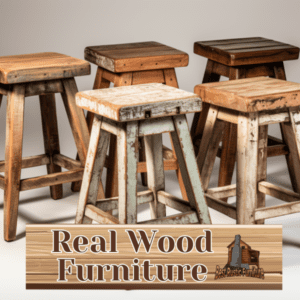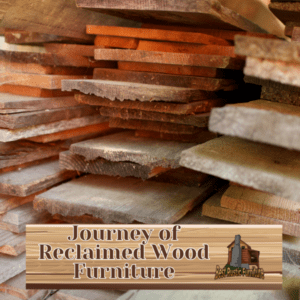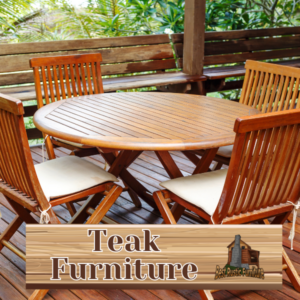
Welcome to the whimsical world of Wood Science in rustic furniture! Brush off the sawdust, take a seat, and get ready to dive into the beloved nature of wood. We’ll chat about the quirky characteristics of different woods and how they make your favorite rustic pieces come to life. From rings to grain, knots to warps, wood is filled with distinct characteristics that charm creators and customers alike. So strap on your safety goggles and let’s unearth the secrets behind the surfaces of your favorite rustic relics!
Exploring the Nature’s Variety of Raw Material: Solid Wood for Rustic Furniture
With the increase in interest for eco-friendly and sustainable interior design options, rustic furniture has become a popular choice among homeowners. This particular category of furniture, often made from solid wood and log materials, offers a unique mix of durability, versatility, and aesthetic appeal that cannot be matched. Round wood furniture, especially, is making waves in the world of rustic design culture.
If you’ve spent any time poring over home decor magazines or websites, you must have come across images of these furniture pieces that make you feel like you’ve stepped into a warm and inviting cabin in the woods. Trust me, it’s no accident! The charm of rustic furniture lies not only in its raw, unrefined look but also in the quality of wood used. Crafted painstakingly by hand, each piece showcases the woodworker’s skill, creating a harmony between the natural elements and human craftsmanship.
One type of solid wood that is often used in the production of this category of furniture is cedar. Loved for its robustness and beautiful texture, cedar is ideal for making log furniture. Cedar logs, with their distinctive knots and grain, give each furniture piece a unique character, making them standout items in any interior setting.
Moreover, using cedar for making furniture also presents a sustainable approach—one that respects the environment. Raw materials like cedar logs are renewable resources, making their use in furniture production a responsible choice from an environmental point of view.
However, quality is paramount when it comes to rustic furniture. A good piece of wood furniture is robust, durable, and made with quality lumber. Lower quality products might look appealing at first, but they lack the longevity and the unparalleled beauty of well-crafted, high-quality pieces. While investing in rustic furniture, look for pieces made using traditional woodworking techniques. Believe it or not, a well-made piece of furniture can last for generations! So this rustic trend doesn’t just add to your home décor, it creates heirlooms.
In conclusion, rustic furniture is more than just an interior design trend. It reflects a lifestyle choice—a choice that favors sustainability and quality over mass-produced, synthetic materials. So, as you explore the vast variety of raw materials nature has provided, remember to pay homage to the beloved nature of wood by opting for solid, round, and log wood furniture!
Branch Out to Get Wood: Lumber, Slab, and Other Products for Your Wood Furniture at Home
No matter how small your home, there’s always room for a touch of rustic charm, and nothing does it better than some wood furniture. But before we dive into the sea of timber, let’s discuss the basics. Wood, in essence, is the hard fibrous material that forms the base of trees or shrubs. It’s categorized into two main types: edge wood and sawn wood. Edge wood, as the name suggests, is the wood derived from the outer edges of the tree. In contrast, sawn wood is the wood cut into planks or boards, commonly referred to as lumber.
Lumber, both hardwood and softwood, is the go-to for furniture makers worldwide. Sawn into different shapes and sizes, it provides the backbone for everything from the small bedside table to the massive dining room set. It’s adaptable, customizable, and thanks to modern harvesting methods, it’s sustainable too. Crafting custom wood furniture requires a set of tools and a love for woodworking. The process can range from using a simple hand saw and sandpaper for smaller projects, up to larger power tools for more extensive work.
So, you’ve got your lumber and your tools. Now what? It’s time to consider the wood’s character. Every piece of wood is unique; its knots, rings, and grain tell a story. When it comes to furniture, a solid base is crucial, but it’s the top that grabs attention. The choice of wood for the top significantly affects the overall appearance and character of the piece. Edge wood, with its distinct grain and characteristics, is often a favorite choice for table tops.
For the ultimate rustic appeal, consider a slab. Often sourced from smaller, community-based sawmills, these large, flat pieces of wood, with bark still intact on the edges, can create some truly stunning furniture pieces. Whether it’s the coffee table in your living room or the centerpiece of your outdoor area, a slab can add a touch of nature to your home.
Ultimately, creating custom furniture means working with wood’s quirks, not against them. The loved nature of wood, with its textures and tones, brings an element of beauty and authenticity to your home. So, whether you’re renovating, decorating, or just adding a few small touches here and there, branching out into the world of wood will open a world of possibilities.
Greg’s Journey into Wood Science: Building Rustic Tables using Solid Wood
Once upon a time, Greg was just a humble admirer of rustic furniture. He loved the raw aesthetic and the way each solid wood piece told a unique story. With a yearning to understand just how wooden furniture harnessed such a wild, yet comforting allure, Greg started a fascinating journey into wood science.
Wood science held many surprises for Greg, who was surprised to find out that wood, so often used for its functional and aesthetic features, was also a complex living ecosystem. Filled with a nature of its own, each piece had its tale redrawn when it was made into furniture for the home, taking on a new purpose and a new, homely identity. The path that led from cutting lumber to showcasing a hand-crafted rustic table was filled with tales of resilience, survival, and transformation.
Greg would often sit at his wooden workshop, surrounded by raw wood, tools, plans, and a bunch of his homemade rustic furniture. It was here that he began to see wood’s beauty – in its rings, in its grain, in the story it told. His love for his rooted companions only grew as he delved deeper into the wood’s interwoven nature. With the knowledge he gathered in his woodworking experience made him respect even more the material he was working with.
He set to work with these natural resources with a live passion that only those who appreciate the true quality of goods made with solid wood would understand. Greg’s experience made his custom pieces feel inherently different. They’re built with an appreciation for the journey that each tree undertook, from growing in a forest to becoming a stunning piece of rustic furniture. This understanding manifests itself in every rustic table Greg built, imbuing them with an irresistible charm that only increases their appeal in a home.
At the end of the day, Greg’s journey into wood science highlighted the intricate relationship between man and nature and how can a simple piece of wood, transformed by skilled hands and a wealth of knowledge, can become a symbol of both nature’s bounty and human creativity. This journey, filled with sawdust, trials, and immense satisfaction, taught Greg that woodworking is not just a craft. It’s an understanding of and respect for the wood that fuels passion for making hand-made custom furniture, fulfilling a need and creating beauty in our homes.
Finishing Rustic Furniture at Home: The Beauty of Wood Furniture Products
The process of finishing rustic furniture at home is an engrossing and rewarding journey into the heart of wood science. Carefully applied oil reveals the grain of the wood, transforming each piece of furniture into a work of art that mirrors the beauty of nature. But perhaps the most appealing aspect of rustic wood furniture is its personality – each piece is unique, with knots, rings, and the bark itself telling the rustic tale of the tree it was made from.
Small factors can greatly influence the feel and look of your rustic furniture. A well-finished table, made with love and attention, can become a centrepiece, radiating warmth and inviting touch. The finishing process often starts with a simple piece of raw wood. This is where furniture and nature intertwine, each piece of bark hinting at the journey from tree to table.
Remember, wood is a living entity, even after being turned into furniture. It continues to respond to its environment. Temperature, moisture, time, and countless other factors play their roles as the wood changes, subtly shifting in hue and texture. Each change underlining why wood furniture is such a beloved and timeless choice for home.
To begin the finishing process, first, it’s recommended to lightly sand the wood furniture. This removes any rough spots and prepares the wood to absorb the finish: usually, a coat of oil. The oil sinks in, nourishing the wood and enhancing the pattern of the grain. The result is a soft, warm glow that brings out every nuance of the wood. The transformation is magical, breathing life into a piece of rustic furniture that was already brimming with potential.
The finish isn’t just about aesthetics though. An integral part of wood science, it helps protect the wood, adding years to its lifespan. Think of it as the final layer of armor that guards your rustic furniture against time and the elements.
For certain furniture pieces, like tables, an epoxy finish might be the choice. Known for its durability and glossy sheen, epoxy can handle all home products that come its way – from hot cups of coffee to icy cold drinks, preventing marks or stains.
The beauty of wood furniture products lies in their eternal connection with nature, the sense of grounding they bring to any home. A well-made, well-finished piece of rustic furniture doesn’t just look good – it feels right. And that’s why, decades later, rustic furniture made from the heart remains the soul of many a home.
And there you have it, folks! A trip into the heart of the forest, following the journey of raw timber all the way to your living room as a piece of stylish, rustic furniture. Wood science not only deepens our understanding and appreciation for these well-loved pieces, but it’s also key to preserving and efficiently harnessing the beauty of wood for generations to come. So the next time you’re enjoying that hearty wooden table or cozying up in that oakwood chair, remember – it’s a piece of nature’s art filled with stories, secrets, and the subtle touch of wood science!






